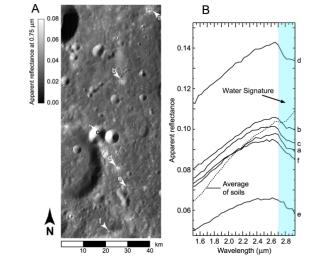skip to navigation

|
Craters and the Tell-Tale Signatures
- Click the image above for a larger view
- Full-Res JPEG (2048 x 1600) (252.4 kB)
- Full-Res TIFF (2048 x 1600) (9.8 MB)
Caption:
Many small, fresh craters bear signatures of water and hydroxyl, which are detected as absorptions of infrared light in the range of 3 micrometers by NASA's Moon Mineralogy Mapper. Figure A, on the left, shows feldspar-rich terrain on the side of the moon facing away from Earth. The arrows point to the location of small, fresh craters. Figure B, on the right, indicates the reflectance as a function of wavelength for craters in Figure A. The water and hydroxyl signature in these regions is seen as a characteristic dip in reflectance in the infrared light near the 3-micrometer range, a region noted with a light-blue band. The dashed line shows background soil that doesn't contain significant water or hydroxyl.
Cataloging Keywords:
| Name | Value | Additional Values |
|---|---|---|
| Target | Moon | |
| System | Earth | |
| Target Type | Satellite | |
| Mission | Chandrayaan-1 | |
| Instrument Host | Chandrayaan-1 | |
| Host Type | ||
| Instrument | Moon Mineralogy Mapper | |
| Detector | ||
| Extra Keywords | Color, Crater, Infrared, Water | |
| Acquisition Date | ||
| Release Date | 2009-09-24 | |
| Date in Caption | ||
| Image Credit | ISRO/NASA/JPL-Caltech/Brown Univ. | |
| Source | photojournal.jpl.nasa.gov/catalog/PIA12234 | |
| Identifier | PIA12234 | |
